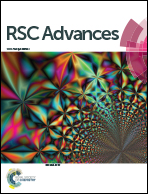Construction of a ternary system: a strategy for the rapid formation of porous poly(lactic acid) fibers
Abstract
Combining electrospinning technology with nonsolvent induced phase separation (ESP-NIPS), 10 wt% poly(lactic acid) (PLA) spinning solutions are prepared by using chloroform as a good solvent and absolute ethanol as a nonsolvent. The “PLA/CHCl3/C2H5OH” ternary system is constituted to realize the rapid preparation of porous-structured PLA fibers. The morphologies, thermal properties and crystalline structures of the obtained fibers are characterized and the rapid forming mechanism of PLA porous fibers is investigated and discussed. The interaction parameters between the substances of the “PLA/CHCl3/C2H5OH” ternary system, binodal line, spinodal line and critical point are obtained by theoretical calculation and experiment, and the “PLA/CHCl3/C2H5OH” ternary phase diagram model is established. The results show that, when the mass ratio of chloroform/ethanol is around 75/25, the rapid “in situ” formation of the PLA fibers can be realized with porous structures within 5–10 s. The establishment of a “nonsolvent-solvent–polymer” ternary phase diagram model has laid a theoretical foundation for the rapid formation of polymer porous fibers by ESP-NIPS. The ESP-NIPS for the porous PLA fibers preparation provides a new resolution for the rapid formation of porous polymer materials, which is vital to further expand the application of electrospun fibers in emergency situations such as isolation, protection, insulation and flame retardant usage.



 Please wait while we load your content...
Please wait while we load your content...